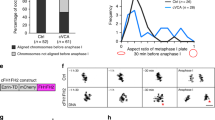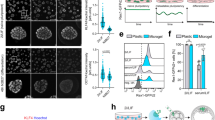Abstract
Cells comprise mechanically active matter that governs their functionality, but intracellular mechanics are difficult to study directly and are poorly understood. However, injected nanodevices open up opportunities to analyse intracellular mechanobiology. Here, we identify a programme of forces and changes to the cytoplasmic mechanical properties required for mouse embryo development from fertilization to the first cell division. Injected, fully internalized nanodevices responded to sperm decondensation and recondensation, and subsequent device behaviour suggested a model for pronuclear convergence based on a gradient of effective cytoplasmic stiffness. The nanodevices reported reduced cytoplasmic mechanical activity during chromosome alignment and indicated that cytoplasmic stiffening occurred during embryo elongation, followed by rapid cytoplasmic softening during cytokinesis (cell division). Forces greater than those inside muscle cells were detected within embryos. These results suggest that intracellular forces are part of a concerted programme that is necessary for development at the origin of a new embryonic life.
This is a preview of subscription content, access via your institution
Access options
Access Nature and 54 other Nature Portfolio journals
Get Nature+, our best-value online-access subscription
$29.99 / 30 days
cancel any time
Subscribe to this journal
Receive 12 print issues and online access
$259.00 per year
only $21.58 per issue
Buy this article
- Purchase on Springer Link
- Instant access to full article PDF
Prices may be subject to local taxes which are calculated during checkout






Similar content being viewed by others
Data availability
Supporting data are available in the Source Data files and from the corresponding authors upon reasonable request.
References
Kollmannsberger, P. & Fabry, B. Linear and nonlinear rheology of living cells. Ann. Rev. Mat. Res. 41, 75–97 (2011).
Guo, M. et al. Probing the stochastic, motor-driven properties of the cytoplasm using force spectrum microscopy. Cell 158, 822–832 (2014).
Davidson, L., von Dassow, M. & Zhou, J. Multi-scale mechanics from molecules to morphogenesis. Int. J. Biochem. Cell Biol. 41, 2147–2162 (2009).
Savin, T. et al. On the growth and form of the gut. Nature 476, 57–62 (2011).
Farge, E. Mechanical induction of Twist in the Drosophila foregut/stomodeal primordium. Curr. Biol. 13, 1365–1377 (2003).
Kahn, J. et al. Muscle contraction is necessary to maintain joint progenitor cell fate. Dev. Cell 16, 734–743 (2009).
Mammoto, A., Mammoto, T. & Ingber, D. E. Mechanosensitive mechanisms in transcriptional regulation. J. Cell Sci. 125, 3061–3073 (2012).
Chen, D. T. N., Wen, Q., Janmey, P. A., Crocker, J. C. & Yodh, A. G. Rheology of soft materials. Ann. Rev. Condens. Matter Phys. 1, 301–322 (2010).
Moeendarbary, E. et al. The cytoplasm of living cells behaves as a poroelastic material. Nat. Mater. 12, 253–261 (2013).
Roca-Cusachs, P., Conte, V. & Trepat, X. Quantifying forces in cell biology. Nat. Cell Biol. 19, 742–751 (2017).
Bao, G. & Suresh, S. Cell and molecular mechanics of biological materials. Nat. Mater. 2, 715–725 (2003).
Lim, C. T., Zhou, E. H. & Quek, S. T. Mechanical models for living cells—a review. J. Biomech. 39, 195–216 (2006).
Trepat, X. et al. Universal physical responses to stretch in the living cell. Nature 447, 592–595 (2007).
Polacheck, W. J. & Chen, C. S. Measuring cell-generated forces: a guide to the available tools. Nat. Methods 13, 415–423 (2016).
Trepat, X., Lenormand, G. & Fredberg, J. J. Universality in cell mechanics. Soft Mat. 4, 1750–1759 (2008).
Keren, K., Yam, P. T., Kinkhabwala, A., Mogilner, A. & Theriot, J. A. Intracellular fluid flow in rapidly moving cells. Nat. Cell Biol. 11, 1219–1224 (2009).
Zimmerman, J. F. et al. Free-standing kinked silicon nanowires for probing inter- and intracellular force dynamics. Nano Lett. 15, 5492–5498 (2015).
Hendricks, A. G. & Goldman, Y. E. Measuring molecular forces using calibrated optical tweezers in living cells. Methods Mol. Biol. 1486, 537–552 (2017).
Gómez-Martínez, R. et al. Silicon chips detect intracellular pressure changes in living cells. Nat. Nanotechnol. 8, 517–521 (2013).
Torras, N. et al. Suspended planar-array chips for molecular multiplexing at the microscale. Adv. Mater. 28, 1449–1454 (2016).
Discher, D. E., Mooney, D. J. & Zandstra, P. W. Growth factors, matrices, and forces combine and control stem cells. Science 26, 1673–1677 (2009).
Lutolf, M. P., Gilbert, P. M. & Blau, H. M. Designing materials to direct stem-cell fate. Nature 462, 433–441 (2009).
Maître, J. L., Niwayama, R., Turlier, H., Nédélec, F. & Hiiragi, T. Pulsatile cell-autonomous contractility drives compaction in the mouse embryo. Nat. Cell Biol. 17, 849–855 (2015).
Lehtonen, E. Changes in cell dimensions and intercellular contacts during cleavage-stage cell cycles in mouse embryonic cells. J. Embryol. Exp. Morphol. 58, 231–249 (1980).
Tzur, A., Kafri, R., LeBleu, V. S., Lahav, G. & Kirschner, M. W. Cell growth and size homeostasis in proliferating animal cells. Science 325, 167–171 (2009).
Zhou, L. & Dean, J. Reprogramming the genome to totipotency in mouse embryos. Trends Cell Biol. 25, 82–91 (2015).
Campàs, O. et al. Quantifying cell-generated mechanical forces within living embryonic tissues. Nat. Methods 11, 183–189 (2014).
Hyman, A. A., Weber, C. A. & Jülicher, F. Liquid-liquid phase separation in biology. Ann. Rev. Cell Dev. Biol. 30, 39–58 (2014).
Yoshida, N., Brahmajosyula, M., Shoji, S., Amanai, M. & Perry, A. C. F. Epigenetic discrimination by mouse metaphase II oocytes mediates asymmetric chromatin remodeling independently of meiotic exit. Dev. Biol. 301, 464–477 (2007).
Suzuki, T. et al. Mice produced by mitotic reprogramming of sperm injected into haploid parthenogenotes. Nat. Commun. 7, 12676 (2016).
Rai, A. K., Rai, A., Ramaiya, A. J., Jha, R. & Mallik, R. Molecular adaptations allow dynein to generate large collective forces inside cells. Cell 152, 172–182 (2013).
Payne, C., Rawe, V., Ramalho-Santos, J., Simerly, C. & Schatten, G. Preferentially localized dynein and perinuclear dynactin associate with nuclear pore complex proteins to mediate genomic union during mammalian fertilization. J. Cell Sci. 116, 4727–4738 (2003).
Chaigne, A. et al. F-actin mechanics control spindle centring in the mouse zygote. Nat. Commun. 7, 10253 (2016).
Rowat, A. C., Lammerding, J. & Ipsen, J. H. Mechanical properties of the cell nucleus and the effect of emerin deficiency. Biophys. J. 91, 4649–4664 (2006).
Hose, BasarabG. et al. Reversible disassembly of the actin cytoskeleton improves the survival rate and developmental competence of cryopreserved mouse oocytes. PLoS ONE 3, e2787 (2008).
Sutovsky, P., Simerly, C., Hewitson, L. & Schatten, G. Assembly of nuclear pore complexes and annulate lamellae promotes normal pronuclear development in fertilized mammalian oocytes. J. Cell Sci. 111, 2841–2854 (1998).
Chew, T. G., Lorthongpanich, C., Ang, W. X., Knowles, B. B. & Solter, D. Symmetric cell division of the mouse zygote requires an actin network. Cytoskeleton 69, 1040–1046 (2012).
Yu, X. J. et al. The subcortical maternal complex controls symmetric division of mouse zygotes by regulating F-actin dynamics. Nat. Commun. 5, 4887 (2014).
Schatten, G., Simerly, C. & Schatten, H. Microtubule configurations during fertilization, mitosis, and early development in the mouse and the requirement for egg microtubule-mediated motility during mammalian fertilization. Proc. Natl Acad. Sci. USA 82, 4152–4156 (1985).
Zenker, J. et al. A microtubule-organizing center directing intracellular transport in the early mouse embryo. Science 357, 925–928 (2017).
Ajduk, A. et al. Rhythmic actomyosin-driven contractions induced by sperm entry predict mammalian embryo viability. Nat. Commun. 2, 417 (2011).
Schäfer, A. Influence of myosin II activity on stiffness of fibroblast cells. Acta Biomater. 1, 273–280 (2005).
Strom, A. R. et al. Phase separation drives heterochromatin domain formation. Nature 547, 241–245 (2017).
Larson, A. G. et al. Liquid droplet formation by HP1α suggests a role for phase separation in heterochromatin. Nature 547, 236–240 (2017).
Quinn, P., Barros, C. & Whittingham, D. G. Preservation of hamster oocytes to assay the fertilizing capacity of human spermatozoa. J. Reprod. Fertil. 66, 161–168 (1982).
Shoji, S. et al. Mammalian Emi2 mediates cytostatic arrest and transduces the signal for meiotic exit via Cdc20. EMBO J. 25, 834–845 (2006).
Yoshida, N. & Perry, A. C. F. Piezo-actuated mouse intracytoplasmic sperm injection (ICSI). Nat. Protoc. 2, 296–304 (2007).
Perry, A. C. F., Wakayama, T., Cooke, I. M. & Yanagimachi, R. Mammalian oocyte activation by the synergistic action of discrete sperm head components: induction of calcium transients and involvement of proteolysis. Dev. Biol. 217, 386–393 (2000).
Suzuki, T., Asami, M. & Perry, A. C. F. Asymmetric parental genome engineering by Cas9 during mouse meiotic exit. Sci. Rep. 4, 7621 (2014).
Burkel, B. M., von Dassow, G. & Bement, W. M. Versatile fluorescent probes for actin filaments based on the actin-binding domain of utrophin. Cell Motil. Cytoskeleton 64, 822–832 (2007).
Suzuki, T. et al. Mouse Emi2 as a distinctive regulatory hub in second meiotic metaphase. Development 137, 3281–3291 (2010).
Acknowledgements
We are grateful to B. Nichols, J. Campos, T. Suárez and C. Tickle for their constructive comments during manuscript preparation and thank Animal Facility support staff for ensuring the welfare of animals used in this work. We are deeply indebted to the late Dino Sharma for help with image collection. We acknowledge support to A.C.F.P. from the Medical Research Council, UK (grant nos. G1000839, MR/N000080/1 and MR/N020294/1) and the Biology and Biological Science Research Council, UK (grant no. BB/P009506/1) and to J.A.P from the Spanish Government, grant nos. TEC2014-51940-C2 and TEC2017-85059-C3 with Feder funding. We also thank the clean room staff of IMB-CNM for assistance with chip fabrication.
Author information
Authors and Affiliations
Contributions
A.C.F.P. and J.A.P. conceived core experiments. M.D., R.G.-M. and J.A.P. performed nanodevice fabrication, T.S. and M.A. performed microinjection and embryo production and M.A. and M.D.V. undertook image collection. Data analysis and modelling were by N.T., M.A., M.I.A., R.C. and J.A.P. A.C.F.P. and J.A.P. wrote most of the manuscript with contributions from the other authors.
Corresponding authors
Ethics declarations
Competing interests
The authors declare no competing interests.
Additional information
Publisher’s note Springer Nature remains neutral with regard to jurisdictional claims in published maps and institutional affiliations.
Supplementary information
Supplementary Information
Supplementary Figs. 1–17, Videos 1–9, discussion, methods and references.
Supplementary Video 1
Animation of the axis of rotation of the nanodevice.
Supplementary Video 2
Brightfield video of mouse zygote during PM.
Supplementary Video 3
Brightfield video of mouse zygote containing microsphere
Supplementary Video 4
Tracking particle migration within an embryo.
Supplementary Video 5
Dynamic surface plot of Utr-mCherry in mouse embryos.
Supplementary Video 6
Fluorescence in mouse embryos containing Utr-mCherry.
.Supplementary Video 7
Brightfield video of mouse embryo containing 25-nm ‘H-comb’ nanodevice
Supplementary Video 8
Brightfield video of ‘scary spider’ mouse embryo containing 25-nm ‘H-comb’ nanodevice
Supplementary Video 9
The effect of actomyosin inhibition is consistent with the GES model.
Source data
Source Data Fig. 1
Statistical source data
Source Data Fig. 2
Statistical source data
Source Data Fig. 3
Statistical source data
Source Data Fig. 4
Statistical source data
Source Data Fig. 5
Statistical source data
Source Data Fig. 6
Statistical source data
Rights and permissions
About this article
Cite this article
Duch, M., Torras, N., Asami, M. et al. Tracking intracellular forces and mechanical property changes in mouse one-cell embryo development. Nat. Mater. 19, 1114–1123 (2020). https://doi.org/10.1038/s41563-020-0685-9
Received:
Accepted:
Published:
Issue Date:
DOI: https://doi.org/10.1038/s41563-020-0685-9
This article is cited by
-
Two mechanisms drive pronuclear migration in mouse zygotes
Nature Communications (2021)
-
Integrating magnetic capabilities to intracellular chips for cell trapping
Scientific Reports (2021)



